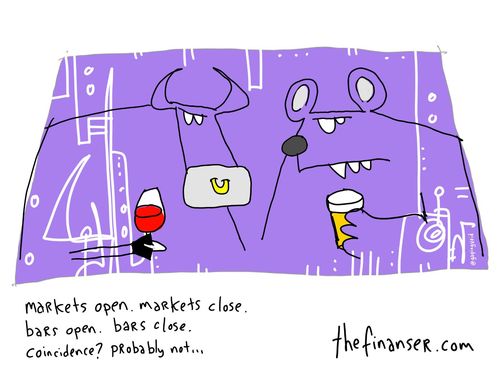The hardy
perennial discussion of whether we need branches or not comes up again this
week. It’s a regular debate on the blog
and in the Financial Services Club, with various entries that are relevant to
contribute towards the debate:
- To dump or not to dump the branch (2007)
- Branches
Wanted: Dead or Alive? (2009) - The
branch-based banking model is dead, Part One (2009) - Branch-based
banking is dead, Part Two (2009) - Bank branches
are not dead (2011) - Do banks need
branches? (Financial Services Club Debate, 2012)
It is a
discussion that never goes away because no-one knows the answer.
In one
corner, you have the techno geeks who think everyone will do banking in an app;
in the other, you have the humanitarians who believe people want to deal with
people.
Somewhere in
the middle is the truth, as I have discussed often (as demonstrated above).
My own view
is that banking will be performed through a smaller number of super-sized
branches, where service, advice and sales are the focus (not transactions,
administration and cash).
We have already
seen this move, and we will see more of it.
So why am I
blogging about this again?
First, because
I am chairing another healthy debate on the subject tomorrow at the Building
Societies Association’s annual binge; and second, because I started a twitter storm when posting a note from John
Ryan – an American firm who design bank branches – that showed banks see
branches today as more important than ever before. This is based upon a survey of over 200 banks
worldwide,
which showed that two-thirds of bankers believe branches are more important today
than five years ago.
The reactions
were swift and dismissive:
@chris_skinner @brettking Am I wrong or JohnRyan's core business is IN-BRANCH materials/activities? Why don't we look at numbers and trends?
— alex colafranceschi (@alecola66) May 6, 2013
@alecola66 @chris_skinner @brettking What did you expect execs responsible for the branch channel to say? :)
— rshevlin (@rshevlin) May 6, 2013
@alecola66 @chris_skinner @brettking I want to know what the 20% who said that the main role of the branch was "Other" was thinking
— rshevlin (@rshevlin) May 6, 2013
@alecola66 @chris_skinner this survey is somewhere between wishful thinking and just being a joke, sorry
— Brett King (@brettking) May 6, 2013
@fsclub @brettking Scanning report, looks like bank execs think branches more important. Consumers may not share same perspective.
— Jenni Palocsik (@verintJenni) May 6, 2013
There was more,
but you get the idea. The twitter storm finished
with a few insights wroth repeating:
@brettking @chris_skinner @verintjenni @alecola66 If low value svc transaction migrate out, and rev gen xactions increase, branch is viable
— rshevlin (@rshevlin) May 6, 2013
@brettking @chris_skinner @verintjenni @alecola66 If low value svc transaction migrate out, and rev gen xactions increase, branch is viable
— rshevlin (@rshevlin) May 6, 2013
Again, there’s
more, but the whole discussion boils down to a few core essentials.
First, branch
square footage versus return on investment is a key balancing act, with a
definite need to decrease the transactional space and increase the sales and
service space.
Second, why
do we still call them bank branches?
These have nothing to do with being branches on a tree anymore, but are
retail outlets or bank stores, not branches.
Third, these
stores may not be popular in some countries, but are essential in most emerging
and developing economies as a place to socialise money matters.
Even in developed
economies, stores are still viewed as essential; why else would RBS have been
able to get Santander’s interest in burying their stores and Co-operative in
Lloyds if bank stores were redundant?
OK, these deals fell through due to economic circumstances, but that had
nothing to do with the store viability.
If anything, these moves prove the viability of bank stores for effective
financial servicing.
Fourth, it is
notable that for all the dialogue about the move to digital, which has killed
most physical store distribution, digitised stores are opening physical outlets. Apple was the first, but we also see PayPal
moving to the physical world (in part, prompted by Square) and others. A great example is Oak Furniture Land, an
eBay store that announced this week it is to open physical stores in
Britain.
For me, it
comes back to two key areas.
One, when the
internet wave first started in the 1990s, my manager said the one thing you
cannot get through the internet is fuel (oil, gas, diesel, petrol). This is still true. There is a need for physicality in some areas
of life. Not everything can be digitised
and, for bankers, the core here is that you cannot digitise the whole
psychology of our relationship with money.
We need a place
to go to engage, talk, get knowledge about and understanding of money. For those who are confident with their lives,
they may never visit a branch but, for the majority of the population, they don’t
understand simple math let alone debit or credits. So they need financial stores to give them
that understanding (note, this is where the gullible gimp opportunity arises).
Two, being a
bank isn’t cheap, and the branch is viewed as the key to gaining customers. This is demonstrated by Metro Bank, in the news
last week for losing over £100 million in
the three years since they opened.
This may seem shocking,
but it’s not at all.
Metro Bank is sinking
money into the UK to create a physical space to compete. Their strategy is clear: we will be the #1
retail financial stores in Britain by 2020, with new bank branches opening
apace. 17 opened so far and a new drive-through
store in Slough opened on Friday and, if you want innovation,
that might be seen as innovation as Britain doesn’t have any drive-through bank stores!
So this is a big
loss-making business, based upon a retail store model?
Maybe, but long-term is
the focus here. Not the short-term.
If you focus long-term,
take note of these numbers:
- Metro Bank, now in its
third year as the new bank on Britain's high streets, almost trebled the number
of current accounts it runs last year from 48,000 to 136,000. - The amount held by savers
rose by 279 per cent to £576m while loans increased fourfold to £168m. - Dissatisfaction with
established banks saw the number of current accounts rise by another 25 per
cent in the last three months.
And the guys backing this
business are no dummies either. They know
they have to seed this funding to growth their footprint to build their banking
business to make money. After all, they’ve
done it before.
So, for all our debate and bluster about bank branches, I
think they’re here to stay. Not in any
shape or form like they were in the past, but in a new form of retailing and
service.
Let’s see what this week debate says.
Chris M Skinner
Chris Skinner is best known as an independent commentator on the financial markets through his blog, TheFinanser.com, as author of the bestselling book Digital Bank, and Chair of the European networking forum the Financial Services Club. He has been voted one of the most influential people in banking by The Financial Brand (as well as one of the best blogs), a FinTech Titan (Next Bank), one of the Fintech Leaders you need to follow (City AM, Deluxe and Jax Finance), as well as one of the Top 40 most influential people in financial technology by the Wall Street Journal's Financial News. To learn more click here...




















